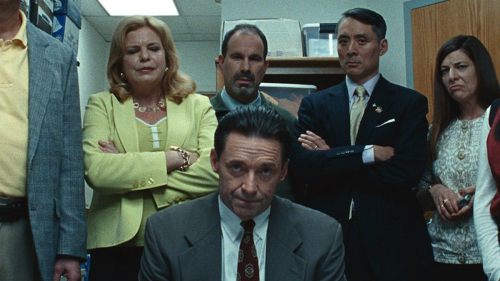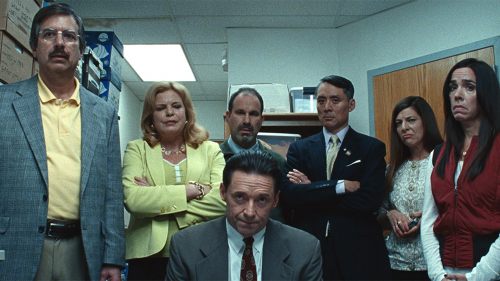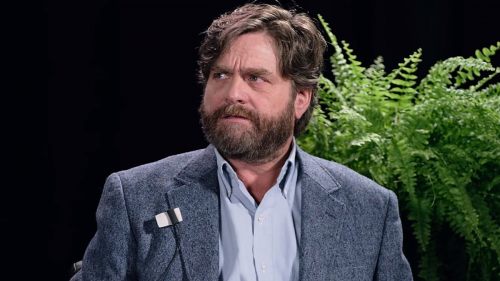A Visit To The Colorful And Adventurous Set Of MISSING LINK
“We want to see our characters breathing,” says producer, Arianne Sutner, about the attention to detail that goes into crafting a film at Laika Studios. From the haunting imagery of Coraline to the magical vision of Japan in Kubo and the Two Strings, the stop-motion animation studio has been captivating audiences with their innovative films for over a decade. In Missing Link, arriving in theaters April 12th, Laika embarks on a journey around the world, stretching their abilities beyond previous productions to tell the story of adventurer Sir Lionel Frost (Hugh Jackman) and his mission to prove the existence of Bigfoot – AKA Mr. Link (Zach Galifianakis). Last month I had the great pleasure of traveling to Portland, Oregon to meet with members of the team for a look behind the scenes at the extraordinary amount of time and hard work that goes into building these cinematic wonders.
Laika is home to an army of talented and dedicated creatives, all of whom have mastered the art of bringing these imaginative stories to life. After seeing a few minutes of footage, it’s clear that Missing Link will have the sort of charismatic heroes and pitch-perfect comedy we’ve come to expect from the studio, while also introducing sights and scenes on a much grander scale. With over sixty unique locations, Mr. Link’s journey around the world promises plenty of high stakes, as well as some Inception level action sequences (trust me, you’ll know it when you see it). Sutner describes the globe-trotting adventure as a “kaleidoscopic color explosion,” crediting writer/director Chris Butler’s (ParaNorman) detail-oriented script as the foundation for the film's vivid color palette and stylistic design. Color was certainly the buzzword throughout my tour, from the impeccable costumes to the elaborate set designs. And you can see it on full display in the latest trailer:
We began the day with an introduction to the puppets — the undisputed stars of the show. Since the characters are the centerpiece of the story, a lot of time is spent on their appearance. “We want the characters to live and have presence in the worlds that are created,” explains Puppet Fabrication Supervisor, John Craney, expanding on Sutner’s earlier sentiment about seeing these characters breathe. His department accomplishes this task by molding each puppet around a metal armature that makes movement and, in turn, their lifelike presence possible. Craney also illustrates that a breathing mechanism has been built into Mr. Link’s armature, allowing the animators to move his belly up and down. From the back, his puppet has a series of levers and handles sticking out of holes in his fur, giving the animators access to easily move him in the ways required for any given scene. The most sophisticated of the puppets due to his odd shape, Link’s armature contains over 250 components, and there are eleven naked and twelve clothed versions of his character alone. At the end of the day, the goal is to trick the audience into forgetting they’re watching a nine-inch puppet on screen. According to Craney, all it takes is “some deep thinking and a little bit of magic.”

Yet, that’s only the beginning of the intense amount of work that goes into constructing a living, breathing character at Laika. Brian McLean’s Rapid Prototyping department oversees the 3D printing of every facial expression the puppets make. Having printed over 106,000 interchangeable faces on Missing Link so far, McLean explains that the puppets are equipped with a mechanism that lets animators quickly pop out one face and replace it with another, depending on the emotional demands of a scene. Now that 3D printers utilize resin instead of powder, the faces look a little more realistic than they did back in the days of Coraline. Another unexpected perk of the latest advancements is that the faces no longer have to be sanded. Add a little paint and some lip gloss and these actors are ready for their close-up.

This is where Ollie Jones and the rigging department come in. For a single close-up, Jones demonstrates how an enlarged version of Link’s mouth was built – increased in size by 600% – and then hooked up to a rig that manipulates both the mouth and tongue to obtain the desired shot. Most rigs are designed for the purpose of giving animators more control over a character, such as during a sequence that calls for a puppet to be thrown through the air by the Loch Ness Monster. For this project they also invented a rig they call the jet-pack, since the controls are mounted on the backs of the puppets. This particular rig is used to make smaller movements appear more natural and fluid. Jones shares that his team draws a lot of inspiration from principles used in stage productions as well as from pioneers like the Jim Henson Company. The innovative tools they build not only give the animators more freedom, they make it possible to create the more complex and dramatic moments of the film.

Of course, we’ve all heard stories from actors about how putting on a costume goes a long way toward becoming a character. The same appears to be true when the actor is only nine inches tall. Costume Designer, Deborah Cook, presents a large bulletin board filled with fabric samples and reference photos representing her journey on the film. Words pinned to the top read “invest with color,” acting as a reminder to harken back to Butler’s vision of vivid colors inspired by the early Victorian era. Photos of Wyatt Earp are clearly embodied in the final puppet of the feature's villain. Everything from the way he stands to the detail on his belt buckle is clearly inspired by the Old West lawman. Cook elaborates on how Adelina Fortnight’s (Zoe Saldana) costumes were designed to express her daring personality. She’s no damsel in distress, and her clothes demonstrate that by being a bit more adventurous than other ladies of her era. Every stitch and pattern is carefully planned and constructed, acting as yet another invaluable tool to bringing the characters and their story to life.

“It’s all about the storytelling,” says Production Designer Nelson Lowry as we walk through some of the breathtaking sets constructed for the film. Each one, from the sprawling forest housing Link’s cave to the temple at Shangri-La sparks an audible reaction of sheer amazement. The scale of each set is the first thing that hits you, followed by the unbelievable amount of realistic details in every building and object as far as the eye can see. But it’s the tiniest objects that draw your eyes, like the numerous stacks of books in Mr. Link’s cave, or the portraits lining the walls of the saloon and Sir Lionel’s office. The fact that we don’t really stop to consider the actual size of things once we’re sitting in the theater is a testament to the craftmanship and artistic sensibilities of every person working behind the scenes. Lowry discusses how every environment was built to represent the characters, acting as an extension of their personalities and where they come from. The studio's commitment to investing a certain level of heart into their stories is apparent throughout every moment of the process.

You might think that seeing behind the curtain would detract from some of the wonder of the final production, but if anything I left Laika more excited than ever to sit in the theater on April 12th to watch Sir Lionel, Mr. Link, and Adelina embark on their grand adventure. The evolution of Laika's artistic endeavors over the years and their remarkable ability to create characters from the ground up and make them talk, move, and, yes, breathe, is a sight I wish everyone could have the opportunity to see in person. It’s easy to get swept up in the fun and adventure of these films so much that you do forget you’re watching puppets inhabit an imaginary world, and that’s the quality of storytelling we’ve come to cherish from this outstanding studio. But to forget the incredible amount of time and effort that goes into creating every second of that content would be doing them an incredible disservice. Sure, with a voice cast like Hugh Jackman, Zoe Saldana, and Emma Thompson these characters are bound to come alive. But the real heart of a Laika picture beats behind the scenes, where hundreds of dreamers work together every day to make a singular vision a reality.



